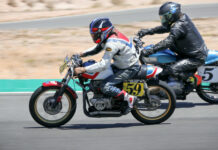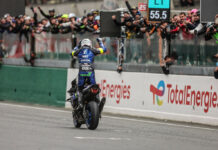After two demanding back-to-back races at Mugello and Barcelona, followed by an important two-day test at the Catalunya circuit, the Ducati Marlboro Team now face up to another double-header on two of the World Championship’s most historic circuits. The first takes place in the unpredictable surroundings of Donington Park, a circuit that combines a high-speed opening section followed by a series of tight and twisty hairpins, where the only consistent thing about the weather is its inconsistency. The home of British Grand Prix offers notoriously low levels of grip in the wet and the forecast for this weekend is as uncertain as tradition dictates – as will no doubt be the case when the season continues just six days after this Sunday’s race at Assen. Casey Stoner isn’t the biggest fan of the English circuit despite having made his Grand Prix debut there back in 2001 and since forging an impressive record in the MotoGP class. Last season he took victory with a stunning fight-back after dropping to seventh on the first lap, whilst as a rookie in 2006 he came through from eighth on the grid to finish less than two seconds off the podium. In the 250cc class in 2005 he did finish on the podium, however, in third place. Marco Melandri also has a victory at Donington Park on his CV, having triumphed there in the 250cc race in 2002. In 2001 he finished third in the same category and returned to the podium in 2006 with another third place in the MotoGP race. LIVIO SUPPO, MotoGP Project Director “We head to Donington after two positive days of testing for Casey in Catalunya with both next year’s bike and the current GP8. He is in great form and riding fantastically well, as he showed with that masterful pole position in Barcelona and a great fight with Valentino in the race. Marco has struggled with some difficult races since China but we’re working hard on all fronts to try and help him recover confidence with the tools at his disposal and develop an understanding with the bike.” CASEY STONER, Ducati Marlboro Team “I’ve never really liked Donington much but I have had some good results here so I have good memories. In my rookie MotoGP year in 2006 I finished fourth, close to the podium, and last year I won. It was a wet race but even on slick tyres in the dry during practice we were looking strong. The first part of the track is really tough, with the long, downhill Craner Curves and then up to the Old Hairpin, where you’re braking with the bike leaned over, moving around all over the place. Some of the other corners are really slow and it’s difficult to find the right set-up for the race because of the difference between the two sections. The slow part is really important because that’s where you can pass people, whilst the fast sections give you a chance to make up time and escape if you are ahead or catch somebody up if you’re behind. It’s a really tough compromise to make.” MARCO MELANDRI, Ducati Marlboro Team “Donington is always a bit of a special race for me because I live just a couple of miles from the track. It is a strange circuit, with a very fast part and a very slow part but I like it quite a lot. The big question mark at Donington is always the weather: the temperature can change quickly and a bit of rain can change the track conditions drastically. For us that could be a problem because we need as much time as possible during practice to find a set-up that allows me to improve my feeling a bit. To have consistent weather conditions all weekend, which doesn’t seem to have happened yet this year, would at least be a positive start.” THE TRACK Donington Park is a circuit of contrasting characteristics. After two high speed splits, the second half of the circuit becomes slow and tortuous. The first part, made up of the famous “Craner Curves”, a super-fast right-left-right sequence requires a smooth approach from the rider and puts machine importance more on handling than outright speed. The back section, meanwhile, was added in 1986 to bring the track up to the minimum length to host a Grand Prix. It consists of three short straights, a chicane and two sharp hairpins that put huge emphasis on braking and acceleration. Setting a bike up is always a question of making compromises but at Donington Park this is the case more than ever and it puts the riders and the bikes to the test. The circuit was added to the calendar in 1987 in place of Silverstone, home to the British Grand Prix since the middle of the 1970s, when the TT circuit on the Isle of Man was finally judged to be too dangerous.
Stoner Says The Two Distinct Parts Of Donington Park Force Compromises To Chassis Set-Up
Stoner Says The Two Distinct Parts Of Donington Park Force Compromises To Chassis Set-Up
© 2008, Roadracing World Publishing, Inc.






